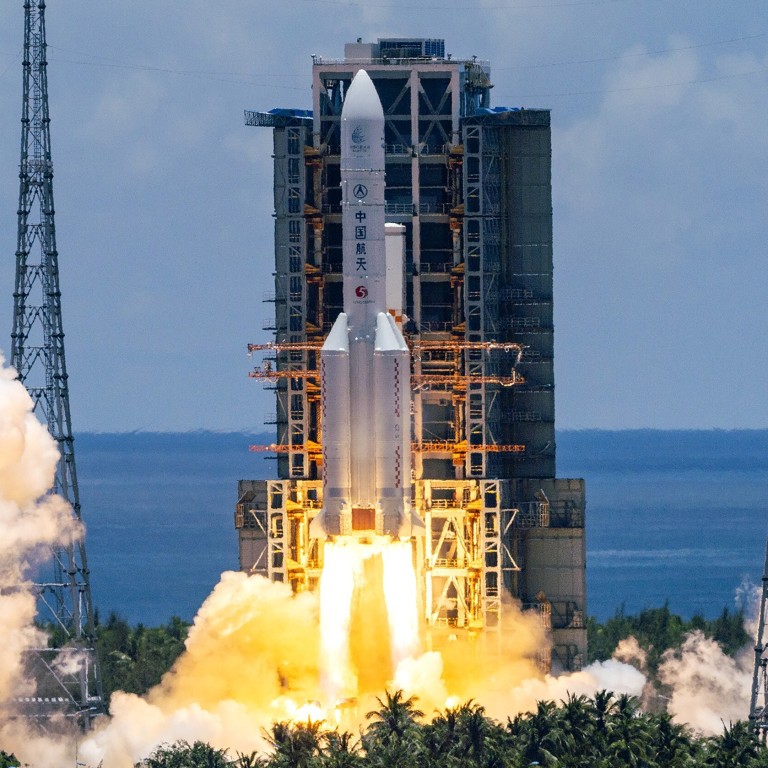
China bolsters its ambitious space programme with the high-powered vision of a new antenna array
- Three new radio telescopes added to Kashgar station to create a deep-space tracking facility for Chinese lunar and interplanetary missions
- System is up and running two months after China denied contract extension for use of space tracking station in Western Australia
Based in Kashgar, the westernmost corner of China, the system comprises four 35-metre (115-foot) diameter radio telescopes – three of them newly built – that form an array capable of recording signals equivalent to a single 66-metre radio telescope, China News Service reported.
The system has enhanced data-receiving sensitivity and can “provide powerful support to different kinds of deep-space explorations”, the report said.
While it is unclear when the lease runs out, the Swedish state-owned company said in September the decision was based on the “complexity of the Chinese market, brought about by the overall geopolitical situation”, adding that it would not seek new business with China, according to Reuters.
Swedish agency warns satellite station could be serving Chinese military
To support its lunar and interplanetary spacecraft missions, China has since 2012 built a deep-space network of large antennas and communication facilities. Besides Kashgar it has ground control stations in the eastern city of Qingdao and northeastern city of Jiamusi, and a third in Argentina’s Neuquen province.
It has also built 50-metre and 40-metre antennas, respectively, in Miyun, near Beijing, and the southwestern province of Yunnan.
According to Li Sihu, head of the Kashgar monitor station, the system can track a single deep-space probe while each of the telescopes can individually monitor multiple objects.
The system could also work with telescope facilities in other parts of China and around the world to carry out joint radio astronomy observation, he said.
Beijing-based military affairs commentator Zhou Chenming said that due to the difficulties of building monitor stations overseas, the Chinese system was not perfect, “but with proper optimisation … the tracking effects won’t be affected”.
Beijing is steadily advancing its space ambition, a key component of President Xi Jinping’s plan for the “great rejuvenation of the Chinese nation”.
China’s new solar telescope is for now the biggest in operation
The mission, named for the Chinese moon goddess, would place a lander on the moon that could drill as deep as two metres beneath the surface to collect rocks and other material to be brought back to Earth by the end of the year. It would be the first time since the American and Russian missions of the 1960s and 1970s that lunar material would be gathered for study.
While China insists its space programme is for peaceful purposes, its rapidly improving capabilities are among the many front lines of its rivalry with the US, from trade to technology and ideology.
US officials, including former defence minister Mark Esper, have accused Beijing and Moscow of weaponising space. The Trump administration last year launched America’s new space force, which Beijing has described as a “direct threat to outer space peace and security”.
In June, the Pentagon released a new Defence Space Strategy, which aims to maintain the space superiority of the US while listing China and Russia as “the greatest strategic threat due to their development, testing and deployment of counter space capabilities”.
CNS reported that the antenna system began operating “recently” and was now involved in missions such as Tianwen-1, China’s interplanetary mission to Mars and Chang’e-4, a robotic spacecraft mission which achieved the first soft-landing on the far side of the moon early last year.
China National Space Administration said on Tuesday that the Tianwen-1 robotic probe – which had flown for 116 days in an Earth-Mars transfer trajectory toward the red planet – was in good condition and was expected to make a soft landing on Mars in May next year.
Additional reporting by Liu Zhen

